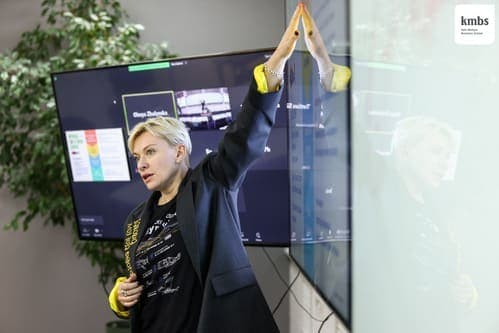Learn first
KMBS latest news in real time

For the latest KMBS events and news, visit KMBS Live at the top right corner of the screen
Open kmbs live 21.02.2022
21.02.2022 3118
3118 0min
0minWhat are the current trends in Fintech?
Gregory Perelman: This area is very broad, and although I work in it every day (I deal with small business financing strategies), it is difficult for me to cover it entirely. I was recently asked to conduct an introductory course on Fintech at the university, which would consist of 5 topics. So, each topic is a separate direction in Fintech! And you can form a full-fledged course on each of them!
Of course, Fintech has more than five directions: first, there are loans that new players issue in a way that totally differs from that of the traditional banks. The second direction is payment systems and payments. 40% of the banking business is about payments. Fintech companies today want to break down the payment process into small parts and possibly change each one of them.
Yet another topic is cryptocurrencies and blockchain, digital money. Many countries are now thinking about creating their own digital currencies, and the Chinese central bank has already done so, just before the Olympic Games.
With the development of big data, the way insurance companies do their business is changing. Today, they are also a part of Fintech: the data allows them to study how consumers behave and, accordingly, to shape the price of products depending on this behavior.
Fifth, investment management is changing. As a rule, companies and financial advisors work for a commission, which is 1-2% of the assets that the client provides to them for management. If you transfer USD 1 million, you will have to pay USD 10 thousand annually, regardless of whether you have earned or lost during this period. And some funds charge even more if the profit exceeds a certain value. Instead, Fintech offers “robotic consultants”, i.e. programs that analyze assets and offer financial advice. And it is much cheaper. In addition, the younger generation is more accustomed to working with algorithms than people.
Sixth, the Fintech area is now setting up companies to help financial institutions comply with regulatory requirements. For example, to avoid racial discrimination, banks should provide the regulator with information on who borrows money from them. And special companies help collect this data and analyze it.
And Fintech has reached the real estate market. Zillow has decided to make this market work the same way as the stock market: come, buy, and sell. This has never happened before, but for an average American, buying real estate is the biggest purchase of a lifetime.
The business model of issuing money for secured assets (as in stablecoins) has been around for 200 years, only the form of money has changed to digital
What is Fintech driven by? Is it by the emergence of new technologies, business models or by something else?
G.P.: Technology is not always the most important factor in change. For example, the introduction of the iPhone was not a revolution in technology. Earlier, there was Pilot, a personal assistant that looked like a telephone. Apple did not invent a new technology; it only combined the phone with an assistant. And as a result, we have a product we cannot exist without right now.
As for the models, often, without realizing it, we use long-invented ones. Examples are digital currencies (not to be confused with cryptocurrencies) or tokens. Financial institutions can issue tokens for certain assets, and these tokens function like money. This is what Facebook has been trying to do since 2019 — creating its own currency, Libra. Was it something new? No, this is a model of a bank of the early nineteenth century.
Then the banks had gold, under which they issued paper money. In the United States in the early nineteenth century, each bank had its own money. If a person came to San Francisco with Boston money and wanted to pay with it, the seller had to get a book with pictures of all sorts of dollars (to check whether they are dealing with real bills). Thus, the business model of issuing money for secured assets (as in stablecoins) has been around for 200 years, only the form of money has changed to digital. Such a model was abandoned then, but it does not mean that it cannot work now.
Of course, there are technologies such as blockchain, which change the whole area and simplify various operations. For example, when a person buys real estate, he or she has to make a lot of different payments for different services. One of the payments is USD 1,000 for the so-called title insurance. This is necessary so that someone does not show up after a while and says, “Actually, this is my house.” If this happens, the insurance company will handle the situation and the owner will not be threatened.
So by paying this USD 1,000, I’m paying for the poor state of the information system. In a year in the USA, such payments reach USD 5 billion! By converting this system to a blockchain, one could get rid of the need to buy title insurance. We would have reliable and accessible records of who owns what.
Why are cryptocurrencies so popular now?
G.P.: First of all, because people today don’t trust the dollar very much, because now the inflation is the highest in a few decades. They want to hide the money somewhere, and cryptocurrencies seem like a good option.
However, in reality, cryptocurrency is not a substitute for money today, although it was invented as an alternative. It is almost impossible to use it for payments in the store; it does not serve as a real currency. However, this does not mean that cryptocurrencies have no future.
Those who use bitcoin expect it to replace the money. But the problem is that it most likely brings us back to the “gold standard”
Do you believe that cryptocurrencies will replace real money sooner or later?
G.P.: There are two views of economists at bitcoin. Some say it’s a bubble because the real price of bitcoin is zero. Others say that your grandchildren will ask you, “Where were you when the money was handed over?” Economist Paul Krugman believes that bitcoin is a very interesting technological solution where cryptography is combined with programming. However, he says the problem for this solution has not yet been invented. So, the modern system works no worse than what bitcoin offers.
Those who use bitcoin expect it to replace the money. But the problem is that it most likely brings us back to the “gold standard.” The number of coins is limited to 21 million units, and there will be no more. When all bitcoins are mined, a new “gold standard” may emerge. However, it was abandoned for a reason, because of the real economic problems! People could not “draw” money, even when the economy was growing, because the currency had to be attached to gold, the amount of which is limited. There was deflation, the economy could not develop.
The man who invented bitcoin was not an economist and therefore could not foresee the problem with the limited number of coins. And we still do not have an answer on how to deal with this issue.
I believe more in digital money, which will be issued by central banks or ordinary banks. However, as of now, the central banks (except China) have not decided whether to create digital currencies using the blockchain and if so, what this system should be — an open (like bitcoin) or closed (like the Ripple platform, which allows one to exchange different currencies).
Likely, central banks will not want to issue digital currency on their own, as this requires each person to be identified when opening an account, as well as different types of auditing, and so on. Central banks may delegate this task to the private system.
Let’s summarize: what is the main difference between cryptocurrencies and digital money?
G.P.: The latter, unlike the former, is backed by real assets. Therefore, digital money does not lose its value as quickly and unpredictably as cryptocurrencies. We all see how sharply the price of bitcoin fluctuates within even one day. This cannot happen with digital money.
The man who invented bitcoin was not an economist and therefore could not foresee the problem with the limited number of coins. And we still do not have an answer on how to deal with this issue
Do you think the idea of cryptocurrency may lose its appeal, if banks start issuing digital money?
G.P.: They say it is difficult to predict, and to predict the future is even more difficult. Therefore, this question cannot be answered unequivocally.
On the one hand, the solution is really beautiful: today, it is impossible to hack the blockchain. On the other hand, this does not mean that it will never happen. Eventually, the introduction of quantum computers, which will count faster by several orders of magnitude, will make this task a reality. This is not expected until 2040, but after that the whole blockchain system may have to be changed. So is it worth switching over to it?
And what do you see as the advantages of digital money over cryptocurrencies?
G.P.: Digital money can be programmed. Imagine there is a downturn in the economy. The central bank issues money to help the population but does so in the form of digital currency, which is programmed to be spent in two months. If this is not done, the money will disappear. So the economy gets a boost, and inflation does not increase.
Thus, digital currency allows the central bank to control not only the amount of money but also how it is used. It is even possible to program it to buy specific product groups.
Doesn’t this pose a risk to privacy?
G.P.: Partly so. After all, the central bank will know who owns every digital dollar. Therefore, democracies are now considering creating a hybrid system: the central bank issues digital money to banks, and they work directly with customers. And the state will not have access to personal data. However, there is no final decision yet on how to build it.
Do cryptocurrencies guarantee privacy?
G.P.: Actually, not completely. When you open an account in cryptocurrency, you get a signature that cannot be matched. But when you start making transactions, all of them are blockchain written. And if someone knows that a certain person bought, say, a house for a million dollars in bitcoin, they could theoretically track other transactions of this person. So even blockchain technology does not guarantee that it is impossible to be identified.
Democracies are now considering creating a hybrid system: the central bank issues digital money to banks, and they work directly with customers
What do you think is the future of the dollar?
G.P.: The dollar may lose its position in the world, however now there is nothing to replace it. China is not an open state, so the only other country to switch to yuan might be Russia. Some believe that cryptocurrencies will become the world’s central currency instead of the dollar. But as of now, I do not see such a prospect.
Before the 2008 crisis, there were about USD 1 trillion printed by the central bank. Over the next three years, the central bank created another USD 4 trillion (this is called the central bank’s reserve). Not all of this money is in the form of paper money. There is only USD 1.2 trillion in paper money. The rest is electronic money, which is transferred from account to account. Many people said that the dollar would now depreciate, but this did not happen. Inflation has been almost non-existent for the past 15 years, rising only over the last year.
Running inflation through the banking system is not that simple: theoretically, every dollar of reserves can support about USD 10 in bank loans. That is, the banking system, based on USD 4 trillion in reserves, could “create” around USD 40 trillion in additional money and provoke inflation. However, this requires active lending, and there is no such need, as the US economy, which grew by an average of 2% a year before the pandemic, does not need such a large amount of loans (and US gross domestic product in 2021 was USD 23 trillion).
Is the current rise in US inflation a threat?
G.P.: To illustrate how inflation occurs, I usually give students an example of toilet paper. When the pandemic broke out, this type of goods disappeared from the shelves. Why did this happen, because demand could not increase so sharply? In fact, the reason was that people stopped going to restaurants and offices where the paper of a different format was used (say, in large rolls). Demand has remained the same, but previously it was met by various formats, and now the need for “home” format of toilet paper has increased. And companies could not quickly reconfigure production.
Another example: during the pandemic, people began to use the money set aside for travel to buy treadmills. Demand increased significantly, and this product began to rise in price. This is a normal market system: if demand cannot be met quickly, the price increase “cuts off” those who cannot pay much.
So the reason for the current inflation is that things are in greater demand than before and people have the financial resources. The United States provided USD 7 trillion in direct aid to the population, and people’s savings increased by USD 2.5 trillion, which is money they could not spend. More money + fewer goods = rising prices.
Another problem is that inflation raises expectations about wage growth, which in turn raises inflation. A similar situation was barely stopped in the 1980s. And now the state must make some decisions to slow down the economy and stop inflation. For example, by raising the interest rate.
Will this step be successful? Most likely it will, but no one knows for how long. Economics, unlike physics, is not an exact science. And now no one can predict what will happen in 1-2 years.










